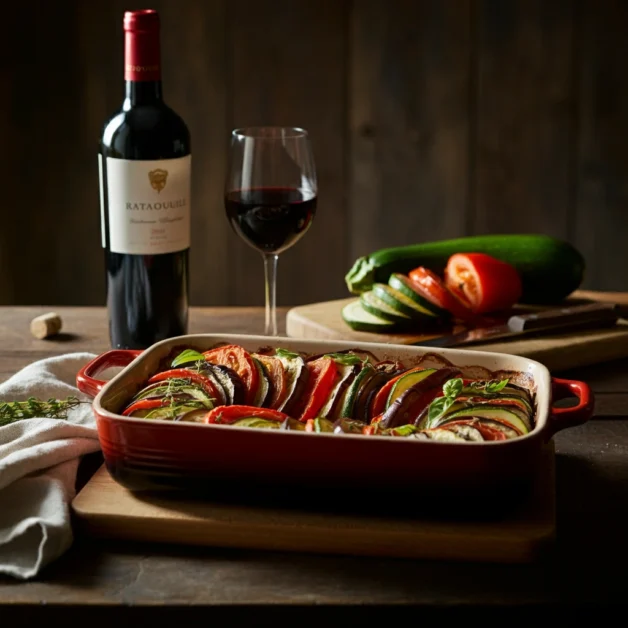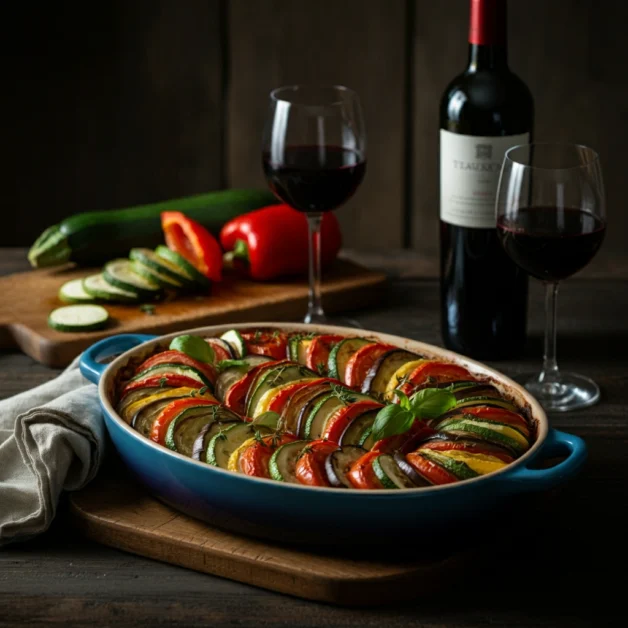Ratatouille, a classic French dish, is renowned for its vibrant flavors and rich history. This colorful medley of vegetables is not only a feast for the eyes but also a delight for the palate. Traditionally made with a variety of vegetables such as tomatoes, zucchini, eggplant, and bell peppers, Ratatouille offers a perfect balance of flavors and textures. But what if you could elevate this already exquisite dish to new heights? The answer lies in a simple addition: red wine.
In this article, we explore the importance of red wine in the Ratatouille recipe. For women who love cooking and discovering new food recipes, understanding the role of wine in enhancing the flavors of this dish is essential. We will dive into how to choose the right wine, the best practices for incorporating it into your recipe, and the nutritional considerations to keep in mind.
The Role of Red Wine in Ratatouille
Red wine has long been a staple in French cooking, known for its ability to enhance the depth and complexity of flavors in a dish. When it comes to Ratatouille, red wine adds a rich, velvety layer of flavor that complements the natural sweetness of the vegetables. The tannins in red wine, which are compounds found in the skins and seeds of grapes, interact with the vegetables to create a more robust and balanced taste.
But the benefits of using red wine in Ratatouille go beyond just flavor. The alcohol in the wine helps to release the aromatic compounds in the vegetables, making the dish more fragrant and flavorful. As the wine cooks down, it also acts as a natural tenderizer, helping the vegetables to soften while maintaining their shape and texture.
For those interested in the science behind cooking with wine, this external resource offers an in-depth explanation of how wine interacts with food during the cooking process.
Choosing the Right Red Wine for Ratatouille
Selecting the right red wine for your Ratatouille is crucial to achieving the desired flavor profile. Not all red wines are created equal, and some may overpower the delicate flavors of the vegetables. When choosing a wine, it’s important to consider the body, tannin levels, and acidity.
- Light to Medium-Bodied Wines: Wines such as Pinot Noir or Grenache are ideal for Ratatouille. These wines have a lower tannin content, which means they won’t overwhelm the dish but will still add a pleasant depth of flavor.
- Acidity: Wines with moderate acidity help to balance the natural sweetness of the vegetables. A wine like Barbera, with its bright acidity, pairs well with Ratatouille.
- Avoid Heavy, Tannic Wines: Wines like Cabernet Sauvignon or Shiraz may be too bold for this dish, as their strong tannins can mask the subtle flavors of the vegetables.
If you’re looking for more guidance on selecting the right wine for cooking, consider exploring this wine guide that provides recommendations based on various cooking needs.
How to Incorporate Red Wine into Your Ratatouille Recipe
Incorporating red wine into your Ratatouille recipe is a straightforward process, but there are a few key tips to keep in mind to ensure the best results.
- When to Add the Wine: The best time to add red wine is after sautéing the onions and garlic but before adding the other vegetables. This allows the wine to deglaze the pan, picking up any flavorful browned bits stuck to the bottom. The wine should be allowed to cook down slightly, reducing by about half, before adding the remaining ingredients.
- Quantity: Typically, 1/4 to 1/2 cup of red wine is sufficient for a Ratatouille recipe serving four people. This amount adds enough flavor without overpowering the dish.
- Balancing Flavors: After adding the wine, taste the sauce. If it’s too acidic, you can balance it with a touch of sugar or a splash of balsamic vinegar. If the flavor is too strong, allow it to simmer for a few more minutes to mellow out.
Incorporating red wine into your Ratatouille not only enhances the flavor but also adds a sophisticated touch to this classic dish.
Nutritional Considerations
While adding red wine to your Ratatouille can elevate the dish, it’s important to consider the nutritional impact. Red wine, when used in cooking, can provide some health benefits, thanks to its antioxidant properties, particularly resveratrol. However, the alcohol content mostly evaporates during cooking, leaving behind the flavor without the effects of alcohol.
Calories: A 1/4 cup serving of red wine adds approximately 50 calories to the dish. While this is relatively low, it’s something to be mindful of if you’re watching your calorie intake.
Health Benefits: The antioxidants in red wine, such as flavonoids and tannins, can contribute to heart health. These compounds help to protect the lining of blood vessels in your heart and may have anti-inflammatory effects.
Common Mistakes to Avoid
Cooking with red wine is an art, and like any art form, there are common mistakes that can be made. Here are a few tips to help you avoid them:
- Using Low-Quality Wine: Always cook with wine that you would enjoy drinking. Low-quality wine can introduce off-flavors that will detract from your dish.
- Adding Too Much Wine: More isn’t always better. Adding too much wine can make the dish taste overly acidic or harsh. Stick to the recommended amounts.
- Not Allowing the Wine to Cook Down: Failing to reduce the wine can result in a dish with an overpowering alcohol flavor. Always allow the wine to reduce by at least half before adding other ingredients.
By avoiding these common pitfalls, you can ensure that your Ratatouille turns out perfectly every time.
Serving Suggestions

Ratatouille with red wine is a versatile dish that can be served in a variety of ways. Here are some serving suggestions to make the most of your culinary creation:
- As a Main Course: Serve Ratatouille over a bed of polenta or alongside a crusty baguette for a hearty, satisfying meal.
- As a Side Dish: Pair Ratatouille with grilled meats or fish for a balanced and flavorful accompaniment.
- With a Complementary Wine: If you’ve used red wine in your Ratatouille, consider serving the same wine alongside the dish to create a harmonious pairing.
For an even more comprehensive meal, you might consider serving Ratatouille alongside the Arlington Chicken Salad. The fresh flavors of the salad provide a perfect contrast to the rich, warm flavors of the Ratatouille.
Conclusion
Red wine is a fantastic addition to the traditional Ratatouille recipe, bringing out the natural flavors of the vegetables and adding a depth of flavor that elevates this dish to new heights. Whether you’re an experienced cook or a beginner in the kitchen, incorporating red wine into your Ratatouille is a simple yet effective way to enhance the dish.
By following the tips and guidelines provided in this article, you can confidently add red wine to your Ratatouille, knowing that you’re creating a dish that is not only delicious but also rich in flavor and history. Remember to choose a wine that complements the ingredients, incorporate it at the right stage of cooking, and enjoy the wonderful results.
For more culinary inspiration and to discover new recipes, be sure to explore the variety of content available on RuthRecipes, including the Gin Martini Recipe and the Jalbitedrinks Liquor Recipe.
